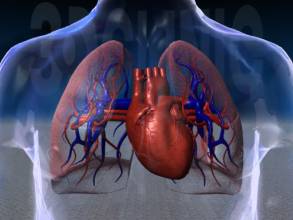Then it goes into-- and I'll go into more detail-- into the left ventricle and then the left ventricle pumps
之后我們會詳細介紹。血液流入左心室
that oxygenated blood to the rest of the body via the non-pulmonary arteries.
然后左心室通過非肺部的動脈將血液擠壓輸送至身體各處
So everything pumps out.
血液流向身體各處
Let me make it a nice dark, non-blue color.
我用不是藍色的顏色標一下
So it pumps it out through there.
血液這么流動
You don't see it right here, the way it's drawn.
可能大家看不太清
It's a little bit of a strange drawing.
這樣看可能不太好理解
It's hard to visualize, but I'll show it in more detail and then it goes to the rest of the body.
可能大家覺得很難理解,之后我們詳細介紹這樣血液流向身體各處
Let me show you that detail right now.
大家看
So we said, we have de-oxygenated blood.
我們講過了,這里是缺氧血

Let's label it right here.
我們標一下
This is the superior vena cava.
這里是上腔靜脈
This is a vein from the upper part of our body from our arms and heads
這是來自身體上部的胳膊,頭部等的靜脈
This is the inferior vena vaca.
這里是下腔靜脈
This is veins from our abdomen and from our legs and the rest of our body.
這條靜脈是來自腿部和身體其他部分
So it first enters the right atrium.
首先血液進入右心房
Remember, we call the right atrium
之所以這是右心房
because this is someone's heart facing us, even though this is on the left-hand side.
因為我們跟這個人是面對面,他的右邊就是我們的左邊
It enters through here. It's de-oxygenated blood.
好,缺氧血從這里流入
It's coming from veins. the body used the oxygen.
身體耗掉氧氣之后,血液從靜脈流入
Then it shows up in the right ventricle, right?
然后進入右心室
These are valves in our heart.
這些是心臟中的瓣膜
And it passively, once the right ventricle pumps and then releases,
當右心室擠壓然后放松時
it has a vacuum and it pulls more blood from the right atrium.
產生一個真空氣壓,使得更多血液流入心室
It pumps again and then it pushes it through here.
然后將血液擠壓到這里
Now this blood right here-- remember, this one still is de-oxygenated blood.
大家注意,這里還是缺氧血
De-oxygenated blood goes to the lungs to become oxygenated.
缺氧血只有到了肺部,才會變成含氧血
So this right here is the pulmonary
那么這里
I'm using the word pulmonary because it's going to or from the lungs.
單詞pulmonary的意思就是趨近或遠離肺部
It's dealing with the lungs.
就是跟肺部有關的
And it's going away from the heart.
這里是遠離心臟
It's the pulmonary artery and it is de-oxygenated.
肺動脈輸送缺氧血
Then it goes to the heart, rubs up against some alveoli and then gets oxygenated and then it comes right back.
血液通過與肺泡的作用,重新補充了氧氣,流回心臟
Now this right here- and it comes back just like that- this right here we're going to the heart.
大家看,血液流回心臟
So that's a vein.
這是一條靜脈
It's in the loop with the lungs so it's a pulmonary vein and it rubbed up against the alveoli
這是肺循環的一部分,是一條肺靜脈通過和肺泡的作用
and got the oxygen diffused into it so it is oxygenated.
補充了氧氣,變成了含氧血
And then it flows into your left atrium.
然后流回左心房
Now, the left atrium, once again, from our point of view,
重申一下
is on the right-hand side, but from the dude looking at it, it's his left-hand side.
在我們看來,左心房是在我們右邊,但對這個人來說,確實是在左邊
So it goes into the left atrium.
血液進入左心房
Now in the left ventricle, after it's done pumping,
在左心室完成上一次血液的擠壓輸送之后
it expands and that oxygenated blood flows into the left ventricle.
心室舒張,血液從左心房流入左心室
Then the left ventricle-- the ventricles are what do all the pumping--
心室才是擠壓輸送血液的部分
it squeezes and then it pumps the blood into the aorta.
心室收縮,血液就流入了大動脈
This is an artery. Why is it an artery?
這是一條動脈,為什么這是動脈呢?
Because we're going away from the heart.
因為現在是遠離心臟
Is it a pulmonary artery?
那么這是一條肺動脈嗎?
No, we're not dealing with the lungs anymore.
答案是否定的,現在已經跟肺部沒什么關系了











